New products at Crocus
by Sarah - October 21st, 2010.Filed under: Crocus, New Products.
New lines at Crocus
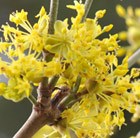
dogwood £39.99
Position: full sun to part shadeSoil: any moderately fertile soilRate of growth: fast-growingFlowering period: May and JuneHardiness: fully hardyA fast-growing, deciduous shrub or multi-stemmed tree that has many charming features. This makes it a valuabe addition to the garden, where it will add interest throughout the year. In late winter, loose clusters of yellow flowers create a haze of colour on the bare stems and these are followed by bright red, edible fruits. The dark green foliage emerges in spring after the flowers and will turn brilliant shades of red and purple in the autumn. After the last leaf has fallen, the flaking bark on the stems creates further, but perhaps more understated appeal.Garden care: In early spring remove any misplaced or crossing branches and apply a generous 5-7cm (2-3in) mulch of well-rotted garden compost or horse manure around the base of the plant.
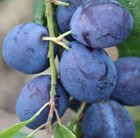
damson £34.99
Position: full sunSoil: will tolerate most soils, except very chalky or badly drainedRate of growth: averageUltimate size on St. Julien A rootstock: 4 x 4mFlowering period: April to MayHardiness: fully hardyDamsons are a great fruit to grow if you are a novice gardener as they are hardier than its closest relative, the plum, and will cope with a wide range of soils. Merryweather is an excellent all-rounder. It is a self-fertile variety that produces larger than average fruits, which have a blue-black skin and juicy, acidic, yellow flesh. These will be ready to harvest from late August.Garden care: When planting incorporate lots of well-rotted garden compost in the planting hole and stake firmly. Prune in summer to reduce the risk of silver leaf and bacterial canker.

damson £34.99
Position: full sunSoil: will tolerate most soils, except very chalky or badly drainedRate of growth: averageUltimate size on Pixie rootstock: 3 x 3mFlowering period: April to MayHardiness: fully hardyDamsons are a great fruit to grow if you are a novice gardener as they are hardier than its closest relative, the plum, and will cope with a wide range of soils. Merryweather is an excellent all-rounder. It is a self-fertile variety that produces larger than average fruits, which have a blue-black skin and juicy, acidic, yellow flesh. These will be ready to harvest from late August.Garden care: When planting incorporate lots of well-rotted garden compost in the planting hole and stake firmly. Prune in summer to reduce the risk of silver leaf and bacterial canker.
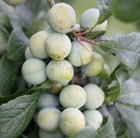
Cambridge gage £32.99
Position: full sunSoil: will tolerate most soils, except very chalky or badly drainedRate of growth: slow growingUltimate size on Pixie rootstock: 3 x 3m (10x10ft)Flowering period: MayFlower colour: whiteOther features: a juicy culinary or desert gage (early September)Hardiness: fully hardyReliable, heavy cropping gage that is similar to the old ‘Greengage’ variety. Single, cup-shaped white flowers appear in late spring, followed by yellow-green fruit with a superb, juicy flavour, which are ready for picking in early September. A good, vigorous grower that does set some fruit without a pollinator, though planting a late flowering plum, such as ‘Marjorie’s Seedling’ will increase cropping. The plants we sell in a 10lt pot are grafted onto St Julian rootstock and will produce a bush with an eventual height of around 6m. They are currently 1.2 – 1.5m tall and are approximately 2 years old. Greengages will generally start to produce fruit when they are 3 – 4 years old, so you may need to wait a year or two before you enjoy the harvest.Garden care: When planting incorporate lots of well-rotted garden compost in the planting hole and stake firmly. Prune in summer to reduce the risk of silver leaf and bacterial canker.
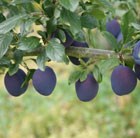
damson £31.99
Position: full sunSoil: will tolerate most soils, except very chalky or badly drainedRate of growth: averageUltimate size on Pixie rootstock: 3 x 3mFlowering period: April to MayHardiness: fully hardyDamsons are a great fruit to grow if you are a novice gardener as they are hardier than its closest relative, the plum, and will cope with a wide range of soils. Native to the West Midlands, this small, compact tree was originally found in the local hedgerows. It is a self-fertile variety with medium sized fruits that can be cooked or baked and used in a variety of tasty recipes.Garden care: When planting incorporate lots of well-rotted garden compost in the planting hole and stake firmly. Prune in summer to reduce the risk of silver leaf and bacterial canker.
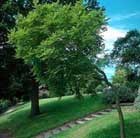
Pride Of India £19.99
A wide-spreading tree which is better suited to a medium to large garden. Beautiful divided leaves emerge pink, turning mid-green as they mature before becoming butter-yellow in autumn. In mid- to late summer, large panicles of dainty yellow flowers appear which are followed by conspicuous bladder-like fruit.Position: full sunSoil: well-drained soilRate of growth: averageFlowering period: July to AugustFlower colour: yellowOther features: a good tree for a medium to large gardenHardiness: very hardyGarden care: Requires minimal pruning. Remove any broken, diseased or crossing branches in late autumn or winter. When planting incorporate lots of well-rotted garden compost in the planting hole and stake firmlyGoes well with: Cistus x cyprius, Euphorbia characias subsp. wulfenii, Phlomis italica, Helianthemum ‘Wisley Primrose’,Anthemis tinctoria ‘E. C. Buxton’, Campanula persicifolia ‘TelhamBeauty’

hydrangea £19.99
Position: full sun or partial shadeSoil: moist, well-drained, moderately fertile, humus-rich soilRate of growth: fast-growing Flowering period: July to October Flower colour: creamy-white fading to pinkOther features: the flower-heads are excellent in dried flower arrangementsHardiness: fully hardyA recently introduced cultivar of Hydrangea paniculata, which is currently making a big splash ‘on the scene’. It is unique because it has a compact habit, and almost rounded flowerheads, which appear prolifically for a long period from mid summer. It also tends to form a more branching shrub, than many of the other varieties currently available. A wonderful new plant, its creamy-white flowers often emerge with a pale pink eye, and this becomes more pronounced as the flowers mature during the summer.Garden care:To enhance flowering prune hard in early spring, cutting back the previous season’s shoots to within a few buds of the permanent, woody framework of the plant.
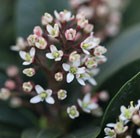
skimmia £14.99
Position: partial to full shadeSoil: moderately fertile, moist but well-drained, neutral to acidic soilRate of growth: averageFlowering period: August to October Flower colour: pinkish-whiteOther features: female plant producing red berriesHardiness: fully hardyWell-shaped domes of neat, evergreen foliage are topped with pretty clusters of scented, pale pink flowers from late summer. As these fade, glossy red berries will develop if there is a male Skimmia nearby. These fruits last well into winter, making this shrub a seasonal joy. It will happily grow in a pot filled with ericaceous compost on a patio or balcony, as long as it is not left to bake in full sun all day, and is kept well watered during the growing season. Alternatively, it makes a wonderful under-storey in a woodland setting, or will add structure to a mixed border.Garden care: Lightly trim after flowering, if necessary. To improve the moisture retention qualities of the soil add plenty of well-rotted compost when planting.

coral bells £8.99
Position: partial shadeSoil: fertile, moist or well-drained soilRate of growth: averageFlowering period: June to AugustHardiness: fully hardyLarge, deeply lobed, burnt orange leaves, that have richer plum central blotch and veining, are the main feature of this shade-loving perennial. A wonderful container plant, it will also look attractive as an under-storey plant on a woodland floor. Garden care: Remove tatty foliage in autumn. Lift and divide clumps every couple of years in early autumn and replant with the crown just above the surface of the soil. Apply a generous 5-7 cm (2-3 in) mulch of well-rotted organic matter around the crown of the plant in spring.
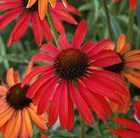
coneflower £7.99
Position: full sunSoil: most soils, except very dry or boggyRate of growth: average Flowering period: June to SeptemberHardiness: fully hardyThe scented flowers of this interesting cultivar open a rich golden colour and gradually take on orange tones, before finally turning red as they reach maturity. This creates a striking, multi-coloured effect on one plant. A long-flowering perennial, it will put on a wonderful display from midsummer to mid autumn and looks great dotted through a border with other hot colours. The flowers are attractive to bees and butterflies, and birds will flock to the seedheads.Garden care: Lift and divide congested colonies in autumn or spring. In autumn cut back all dead flower stems to the ground. Coneflowers benefit from a spring or autumn mulch with well-rotted compost.






